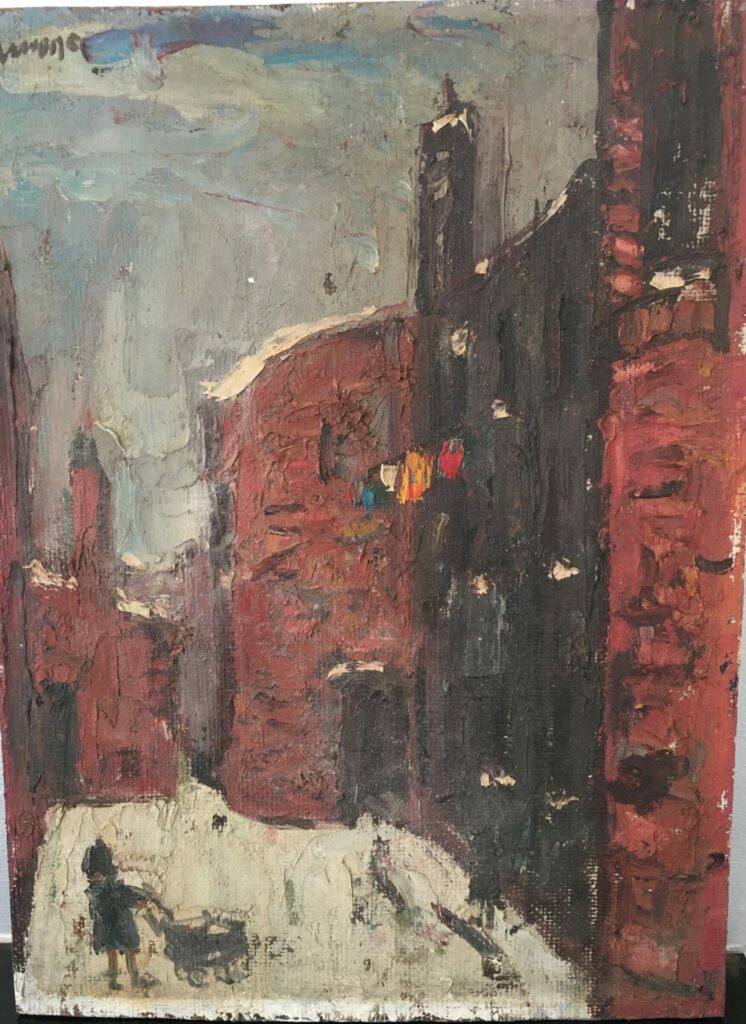
Glasgow has seen more than its fair share of momentous times over the past 100 years but its most pivotal period was probably the late 1950s and early 1960s when the forces of change eradicated the slums and propelled the city into the 20th century. Also swept away was a way of life much mourned but understood by many of Glasgow’s citizens who benefited from the changes but were nostalgic for the past. One of those citizens was the musician and artist Herbert Whone. A Yorkshireman who came to Glasgow in 1956 to take up a role as a violinist with the Scottish National Orchestra. Herbert, or Bert as he was known, took to Glasgow immediately, being fascinated with the people and more importantly the architecture and way of life of ordinary Glaswegians. He was perceptive enough to recognise how rapidly things were beginning to change before his eyes and set about recording them through the medium of painting. Previously he had specialised mainly in portraits of his musical colleagues, amongst them the cellist Paul Tortelier and the conductor Adrian Boult.
My own interest in the work of Bert Whone stretches back to childhood. In the early sixties Bert and my dad, Tommy, crossed paths in a way which still resonates with my family today through one of his original artworks. Although both Bert and my dad are no longer with us their, albeit, brief friendship introduced me to an artist who has been criminally ignored over the years and whose relevance to the history of Glasgow has never been more cogent. It led to me as a four year old meeting Bert and his family and eventually revealing a fifty year old mystery locked away within the painting he gave my dad in 1964.
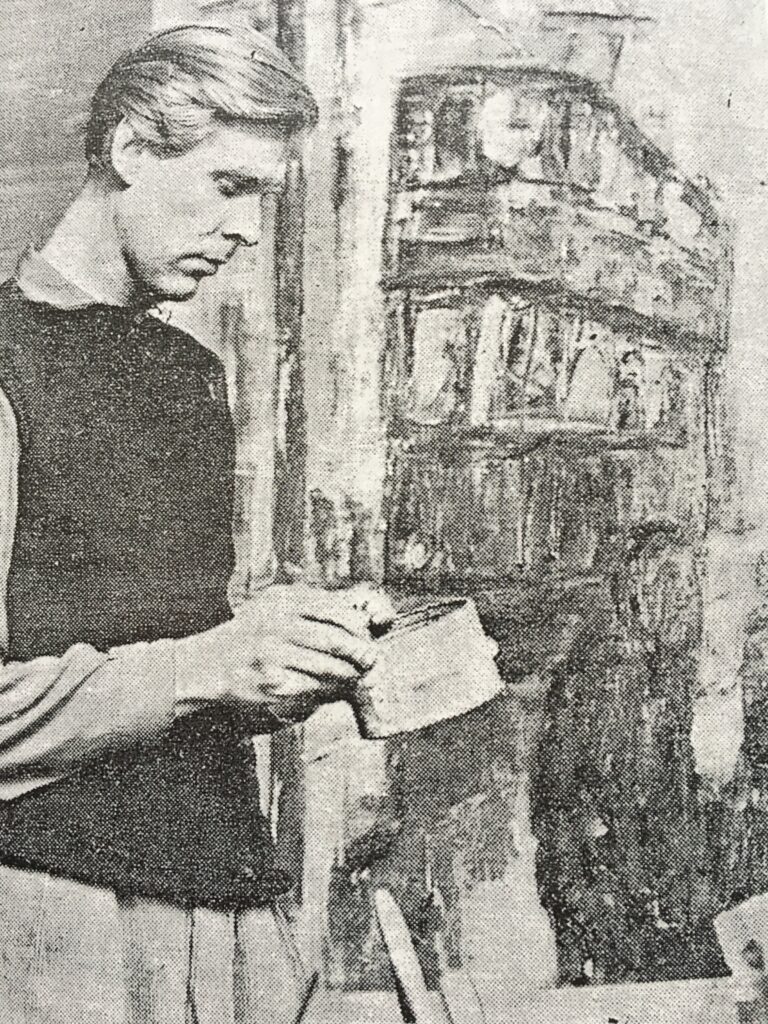
It’s easy to see how Bert and Tommy would have hit it off. In their own ways each could be described as a Renaissance Man. Both were musicians, Bert a violinist , my dad a pianist. They were a similar age with young families and both had a desire to create art, Bert in oils, my dad in watercolours. The unlikely circumstance that brought them together, however, was a fascination for non-mainstream religion and philosophy. This being the early sixties, young people were beginning to question the supposedly cherished beliefs they had been brought up with and were looking for more personal truths and spiritual experiences. Both Bert and Tommy were intrigued by this and met at regular gatherings of those interested in the philosopher and mystic Gurdjieff held at, what is now, Bute House, home of the Scottish Government, in Charlotte Square, Edinburgh.
Before long my mum and dad were making the journey through to Glasgow to Bert and his wife’s house in Otago Street, Hillhead. One of my earliest memories was accompanying them on one of those visits. Compared to the prefab we lived in at the time their house seemed an Aladdin’s cave of adventure. It appeared to have at least three floors and I have vivid memories of running wild with Bert’s children who were of a similar age to me. As we ran up and down various flights of stairs and into every room, other doors led into other rooms. For a four year child it was beyond exciting. The visit also resulted in my, quite literal, footnote in art history. While running frantically through the warren of rooms I inadvertently stepped on something sticky lying on the floor and carried on running without giving it too much thought. This turned out to be a canvas Bert was drying and my one memory of Bert from that visit was of him standing in the doorway holding the damp canvas while my dad lifted my foot up to reveal the offending footprint. It amuses me to think that somewhere in the world a genuine Herbert Whone is hanging on a wall with my 4 year old sandalled footprint hidden under a layer of overpainting.
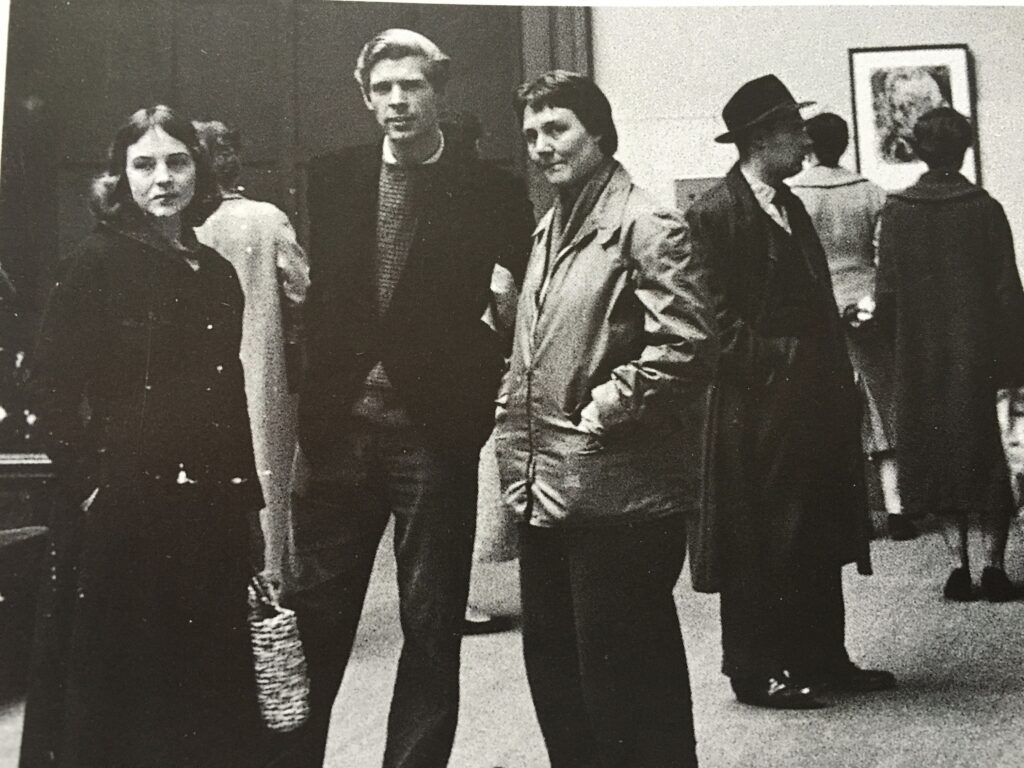
This visit was around mid-1964 and by this time Bert had become known in Glasgow art circles. He had already staged exhibitions in Edinburgh and Glasgow and numbered Joan Eardley and Margot Sandeman amongst his acquaintances. It was also about this time Bert gave my dad the small oil-on-board tenement painting which fascinated me so much throughout my childhood, possibly as a parting gesture as Bert and his family left Glasgow for good shortly after this visit. He had decided to give up performing music publicly and concentrate more on painting but continued to teach and write books on playing the violin, both of which he pursued with great success throughout his life. Sadly, Bert and my dad’s friendship faded as a result of this move as keeping in touch, in the days long before mobile phones and e-mail, took a great deal of effort and both were extremely busy with work, art and, not least, bringing up large young families.

The link to Bert was not severed completely as the tenement painting he presented to my dad remained on the walls of the many houses we lived in for the next 25 years as the family expanded. I’m not entirely sure why I was so fascinated by this picture at such a young age. It may have been due to the style being so different to anything else we had hanging on our walls at this time, most of our art was of my dad’s watercoloured landscapes. I do distinctly remember finding the rudimentary representation of a little girl with a pram, a favourite motif of Bert’s, compellingly strange. I also loved the thick layers of paint and splashes of colour which created such a vibrant tone. Every time I looked at the painting I noticed something different. In 1978 I left home to become a student and the painting disappeared from view. My mum and dad began to downsize as the family went their different ways and the painting, although never slipping from my memory, was certainly shoved to the back of it.
Many years later it was a chance mention while visiting my dad in hospital during the last weeks of his life which fortuitously brought it back into sharp focus. I just happened to ask ‘Whatever happened to that picture I loved of the Glasgow tenements?’ Surprisingly, my brother, who was also present, told me he had it as he had stored some of my mum and dad’s stuff during their last house move. I excitedly arranged to go and pick it up and found the frame was missing as it had been damaged in transit when being moved to my brother’s house. What this revealed was, to me at least, astonishing. The reverse of the picture had hidden a second Herbert Whone painting, one of his early portraits of musical colleagues. For nearly sixty years this image remained secreted behind the tenement painting. Sadly, there was no indication as to who the musician depicted was. The portrait was signed and dated ’56’ which was the year Bert moved to Glasgow to join the Scottish National Orchestra and the figure is holding the neck of a four- stringed instrument, a violin or possibly a cello. At first I felt this may have been a self-portrait and have still not ruled out this possibility. The subject may be too old to be a 30 year-old Bert Whone, though, so the question of his identity may never be resolved, adding a further enigmatic layer to the mystery. However, the practicality of only being able to display one of the surfaces was hugely frustrating.
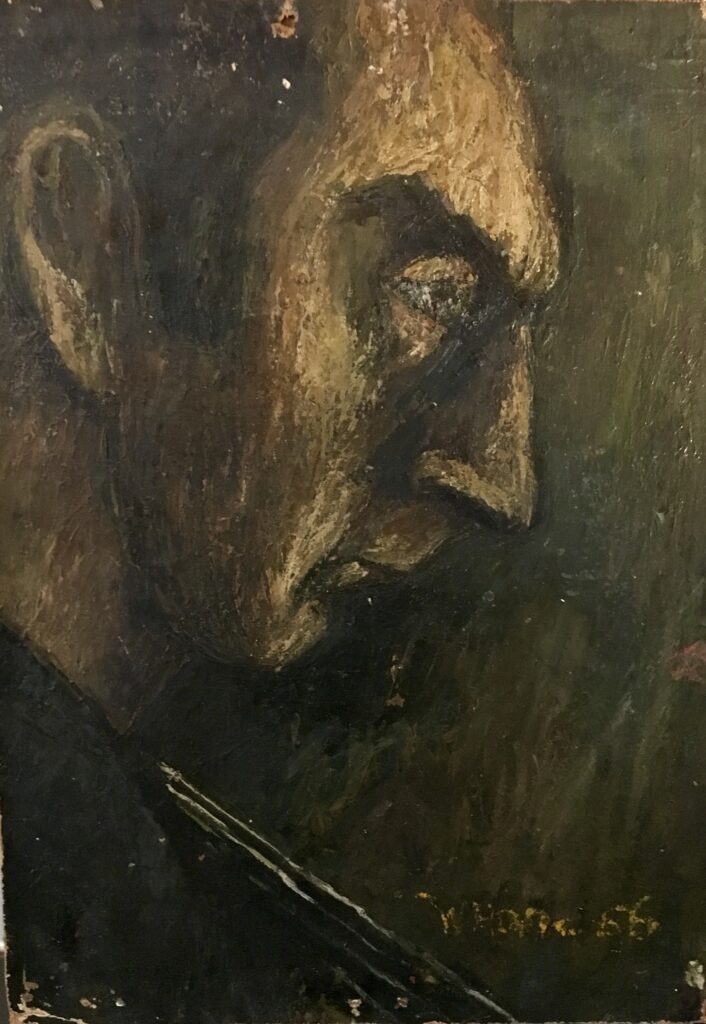
Some rudimentary detective work revealed that our tenement painting was not the only version of this scene painted by Bert Whone. To my knowledge at least two other versions exist. Both of which were titled ‘Back-Court Anderston, 1964.’ One was of the same size as our version (16’’x 12’’) and the other a much larger, more detailed version. Cleaning of the picture also exposed another feature which had, hitherto, gone unnoticed. The small figure of a child was revealed standing by the tenement wall opposite the child pushing the pram. Like the portrait on the reverse side of the painting, this shadowy little figure loitered in the close hidden for nearly sixty years. Being honest, our version was clearly a sketch Bert had completed in preparation for the much larger, more fully developed work but even possessing a Herbert Whone sketch feels like an honour.
I asked my dad just before he died what he remembered of Bert Whone. Unfortunately the drugs he was being treated with had affected his memory significantly but the first thing he said was ‘He was very interested in the trams.’ Trams were another favourite motif of Bert’s work as they were a symbol of the old Glasgow which was about to disappear. Along with the tenements, the shipyards, the closes and horse drawn carriages, Bert documented these elements of a city he could see was changing forever. It is important to stress that he understood and had sympathy for the inexorable nature of change, as he mentions in his excellent book ‘Glasgow in Transition’ (Colin Baxter Photography 1996). All communities go through such periods of transition and rather than bemoan the transformations taking place before his painterly eyes, he looked back on them nostalgically making sure the Glasgow he, and many others, knew and loved would not be forgotten. Many of his most powerful and evocative paintings feature trams hurtling through the mist and fog providing a metaphor for the relentless, unstoppable and inevitable forces of reconstruction.

Bert Whone had a recognisably distinctive style. He lavished paint onto the board or canvas, possibly with a palette knife, creating bursts of colour and swooshes of movement. Some might make comparisons to Lowry and in many ways this is inevitable. Both artists tried to evoke the atmosphere of an industrial city where chimneys, tenements, ships and trams were the stars of the show rather than just the people. That’s not to downplay the importance of people in his scenes as Bert was certainly warmly fascinated by Glasgow’s citizens but he wanted to show how much the architecture and transport of the city was integral to how that city lived and breathed and how it shaped the people, for better and worse. As a self-taught artist Bert was not even aware of Lowry at a time when such information was nothing like as accessible as it is nowadays and, anyhow, Lowry’s star had yet to reach its zenith of clip frame popularity. Alternatively, the watery sunsets and wintry sunrises could also be seen as reminiscent of Turner but, again, his artistic self-education renders such comparisons largely negligible as Bert did not formally study art, his younger life being dominated by music.
It is not a stretch, however, to consider that Bert Whone deserves to be to Glasgow what Lowry is to Manchester. Few artists have depicted the atmosphere of a city on the cusp of such radical and intrinsic change as he did for Glasgow. Lowry paintings can sell for up to £1 million. This is not to suggest Bert Whone’s work should be reduced to merely monetary terms, his legacy is far more important than that but, for me, he is as relevant to Glasgow as Lowry is to Manchester. That said, in 2016 a Herbert Whone winter scene sold for £8000 and in 2017 his oil on canvas painting entitled ‘Close Entrance With Bridge Lamp, Bridgton 1962 sold for £13,200. Clearly there is a growing interest in Bert Whone’s work but so far it’s a small group of aficionados ‘in the know.’

After re-discovering our painting I had it cleaned and re-framed. I asked the conservator and the framer in an Edinburgh art shop, as well as staff at a fashionable Edinburgh gallery, if they knew of Herbert Whone. Not one had heard of him. Both the Gallery of Modern Art in Edinburgh and the Kelvingrove Gallery in Glasgow possess Whone paintings but, to my knowledge, neither has them on display. The time is right for him to be accorded the recognition he deserves as no one documented Glasgow’s transition in the vibrant, atmospheric and distinctive way he did. Arguably few artists represented Glasgow at any time in the way that Herbert Whone did in the 50s and early 60s.
It is not known just how many Herbert Whone paintings are in existence. He did not keep a record of his works or of owners hence most of his prodigious output in the early sixties is probably scattered randomly around walls all over the world. He did keep black and white photographs of a few and managed to track down some of his paintings, photographs of which are displayed in his fascinating book, Glasgow In Transition published in 1996. Amongst the owners of a genuine Herbert Whone was Magnus Magnusson who in 1962 wrote an admiring piece in his Scotsman arts column and described Whone’s desire to capture in his work that ‘fearful energy..that brims and spills into gross inventiveness.…’ It is this quality which deserves to be recognised as well as Bert Whone’s perceptive and beautiful visions of a lost city, much of which is long forgotten and crying out to be remembered.
As a postscript to the above, I have been keeping in touch with art auction houses in an attempt to secure more Bert Whone originals. It is obvious they come up for sale very rarely, which is a testament in many ways to the respect and love owners of his work have for the paintings. A few weeks ago an auction house in Glasgow put up one of his early drawings for sale which I was lucky enough to win. The drawing is ink and paint, signed and dated 1954 and shows a man (or is it a woman?) sitting cross-legged in what could be a baggy brown suit or a monk’s habit. The figure is enigmatic and some further evidence as to the sitter may be revealed when I remove the old frame in preparation for re-framing. 55 years later, Bert Whone still keeps me guessing.
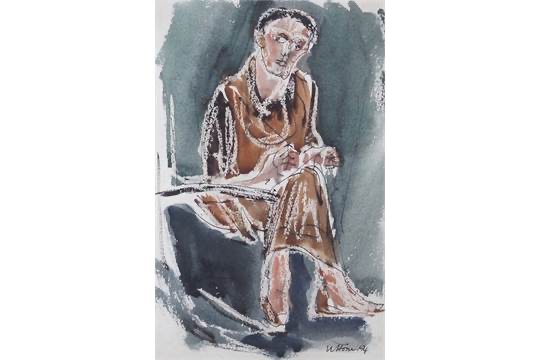
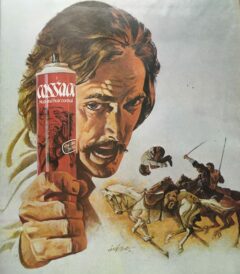
Hello, Love your website, it’s great fun – you have good taste! I am an artist and I found you following a ‘Herbert Whone’ search, he is one of my favourite painters. You are so lucky to own his work. I wondered if you knew that his son, Adam is on Instagram, under ‘adamwhoneviolins’. I recently connected with him after he posted images of his father’s paintings. He was very touched to hear that I was a fan, and sent me some wonderful photographs. He seems a lovely person, I’m sure he would be delighted to hear from you too, and touched by your charming memories. All the best, Rhonda Smith
Hi Rhona
Thanks for that.
Delighted you know and love Herbert Whone. I spend a lot of time asking people who are involved in or just appreciate art whether they know of Herbert Whone. Surprisingly few do although he is becoming more and more popular with those ‘in the know.’.
I was aware of Bert’s son from his website but didn’t know he was on Instagram. I will certainly get in in touch. The photographs sound really interesting.
Have you read Herbert Whône’s book ‘Glasgow In Transition’? It’s fascinating and very well produced. Well worth getting a hold of if you don’t already have it.
Best wishes
D
Sorry Rhonda!
Had a look at your website. Love your work, particularly the landscapes!
Will keep an eye out for your exhibitions when we get back to some semblance of normality.
Sorry, Rhonda!
Sorry Rhonda, called you Rhona earlier!